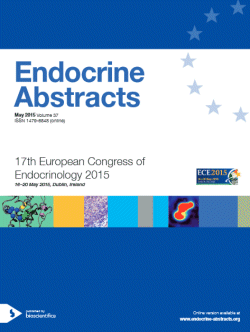Guided Posters
Pituitary–Acromegaly
ea0037gp.19.01 | Pituitary–Acromegaly | ECE2015
Coagulation parameters and platelet function analysis in patients with acromegaly
Yasar Hamiyet Yilmaz , Demirpence Mustafa , Colak Ayfer , Ceyhan Banu Ozturk , Temel Yusuf , Simsek Nese , Karademirci Ismail , Bozkurt Umit
ea0037gp.19.02 | Pituitary–Acromegaly | ECE2015
Assessment of bone quality, measured by trabecular bone score, in acromegaly
Malchiodi Elena , Sala Elisa , Verrua Elisa , Cairoli Elisa , Carosi Giulia , Ferrante Emanuele , Filopanti Marcello , Ulivieri Fabio Massimo , Eller-Vainicher Cristina , Chiodini Iacopo , Mantovani Giovanna , Spada Anna
ea0037gp.19.03 | Pituitary–Acromegaly | ECE2015
Perceived quality of life in acromegaly: results from a tertiary UK centre
Kyriakakis Nikolaos , Lynch Julie , Gilbey Stephen G , Webb Susan M , Murray Robert D
ea0037gp.19.04 | Pituitary–Acromegaly | ECE2015
Molecular and pathological determinants of somatostatin analogue resistance: somatotropinomas in AIP mutated and X-LAG syndrome patients
Lee Misu , Daly Adrian , Rostomyan Liliya , Pellegata Natalia , Beckers Albert
ea0037gp.19.05 | Pituitary–Acromegaly | ECE2015
Clinical and biochemical outcomes during pregnancy in patients with acromegaly
O'Shea Triona , Guptha Saket , Melvin Audrey , McGurran Karen , Casey Ruth , O'Halloran Donal , Gibney James , Thompson Christopher , Sherlock Mark
ea0037gp.19.06 | Pituitary–Acromegaly | ECE2015
Criteria for disease control in acromegaly under SSA treatment: mean GH profile or GH random?
Prencipe Nunzia , Bona Chiara , Karamouzis Joannis , Berton Alessandro Maria , Di Giacomo Stellina Valentina , Guaraldi Federica , Ghigo Ezio , Grottoli Silvia
ea0037gp.19.07 | Pituitary–Acromegaly | ECE2015
Patient experience of living with acromegaly in the UK
Brooke Antonia , Lyttle Jacqui , Goss Lynne , Pobereskin Louis , South West Peninsula Endocrinology Network
ea0037gp.19.08 | Pituitary–Acromegaly | ECE2015
Effects of long-term combined treatment with somatostatin analogues and pegvisomant on cardiac structure and performance in acromegaly
Auriemma Renata S , Grasso Ludovica F S , Galdiero Mariano , Pivonello Claudia , Salzano Ciro , Negri Mariarosaria , Angelis Cristina de , Colao Annamaria , Pivonello Rosario
ea0037gp.19.09 | Pituitary–Acromegaly | ECE2015
Management of pasireotide-induced hyperglycaemia with proactive monitoring and early intervention: key learnings from the phase III, 24-week PAOLA study
Gadelha Monica R , Brue Thierry , Fleseriu Maria , Shimon Ilan , Resendiz Karina Hermosillo , Kandra Albert , Pedroncelli Alberto M , Colao AnnaMaria
ea0037gp.19.10 | Pituitary–Acromegaly | ECE2015
A phase 2 study of antisense oligonucleotide therapy directed at the GH receptor demonstrates lowering of serum IGF1 in patients with acromegaly.
Trainer Peter , Newell-Price John , Ayuk John , Aylwin Simon , Rees Aled , Drake Will , Chanson Philippe , Brue Thierry , Webb Susan , Fajardo Carmen , Aller Javier , McCormack Ann , Torpy David , Tachas George , Atley Lynne , Bidlingmaier Martin




